
Gérard Rubaud Miche
I dedicate my Gérard Rubaud Miche to MC.
(I wish that it could be transported across the Pacific Ocean to reach the other shore.)
It was one of those soulful Van Morrison nights. The music in my tea room could not be any louder; any louder, the gods of silent teapots would have protested. John Donne was in the air. Van Morrison, my muse, dreamt of this miche for me....
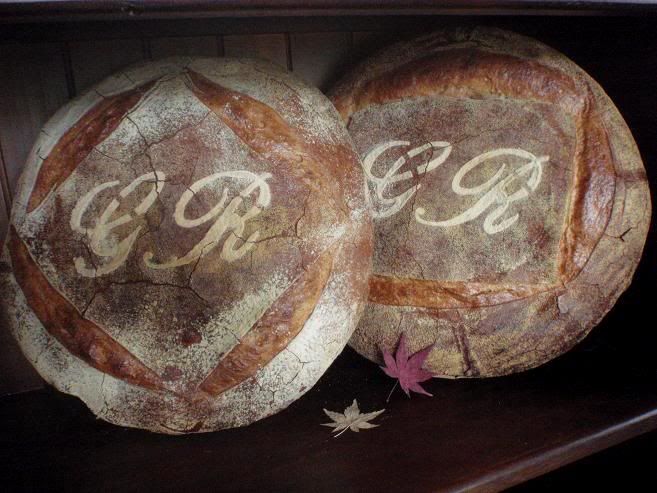
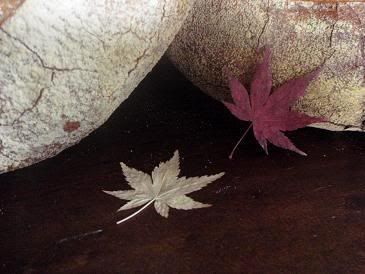
I have neglected my teapots for the longest time now. They have not been polished for ... dare I reveal ... a year? Sounds criminal. Just as well, with all that flour coming out of the surface of the miche, do I need to bother dusting my teapot stands?
Gérard Rubaud starter (re-sized to 2% of his formula as recounted HERE in MC's blog; my figures are for a final dough yield of 1.9 kg, you are welcome to half my quantity again)
First build
- 6 g ripe stiff starter (at this quantity, any starter you've got going is fine, preferably not liquid starter)
- 8 g water
- 14 g flour (2 g WW, 1 g spelt, 1 g rye, and 10 g plain flour)
Note: Gérard Rubaud's starter hydration averages 55.5%. The main thrust of his starter is three refreshes and built with the same flour compositions as for his final dough; ie. 30% whole grains flours (60% wheat, 30% spelt, and 10% rye) and 70% all-purpose flour.
At 30 degree C, this build took 10 1/2 hours for me (overnight temperature might have dropped to 24 - 25 degree C in my kitchen).
Second build
- 28 g starter (from the first build above)
- 16 g water
- 30 g flour (5 g WW, 3 g spelt, 1 g rye, and 21 g plain flour)
At 30 degree C, this build took 6 hours for me..
Third build
- 74 g starter (from the second build above)
- 56 g water
- 100 g flour (18 g WW, 9 g spelt, 3 g rye, and 70 g plain)
Note: Watch your starter fermentation carefully, depending on your room temperatures. As flour (fresh food) is not even 1.5 times the starter, it is very easy to over-ferment at this stage. It was not an issue for the previous two builds as the yeast adjusted to the new flour compositions and began its activity slowly.
At 30 degree C, this build took 4 hours for me (and it was already too long because when I touched my starter, it shrank back very quickly; 3 1/2 hours would have been better). It rose 2 1/2 times.
Gérard Rubaud Final Dough
Main points about the final dough construction are (1) final dough flour is 30% whole grain flours and 70% all-purpose flour as for starter; (2) starter is 25% of final dough flour (ie, 25% baker's percentage); and (3) overall dough hydration is 80%.
- 230 g starter (all from the third build above)
- 920 g flour (165 g WW, 83 g spelt, 28 g rye, and 644 g plain flour)
- 772 g water (every 10 -11 g of water is 1% dough hydration; feel free to reduce water if you wish)
- 20 g salt
Total dough weight was 1,920 grams (minus 150 g as pâte fermentée = 1,770 g, see below) and overall dough hydration was 80%.
Note:
(1) I did double my own formula here (both starter and final dough) because I wanted to do a stencil with Gérard Rubaud initials and I wasn't sure if it would be successful.
(2) I reserved 150 grams from each dough and I had 300 grams as pâte fermentée (old dough) in total from the two doughs. I wanted to try a Poilâne style of miche. Giovanni has done extensive research on Poilâne Miche. Without going into the specifics, all that I wanted to do at this stage was to use Gérard Rubaud's stiff starter and dough with the addition of a reserved old dough to make a miche and see what happens, which I did.
(3) So, in total I made three x my own formula here at two separate occasions, the last being a Gérard Rubaud Miche with pâte fermentée.
Procedure - without pâte fermentée
Gérard Rubaud autolyse flour and water, then he cuts up his stiff levain into small pieces and adds them to the autolysed flour and water mixture. However, the way I did the bread in this post was that I first diluted my starter with water, then I added flour and salt into the diluted starter, then I followed the procedure below.
- Autolyse 20 minutes.
- Five sets of S&F's of 30 strokes each at 30 minutes intervals.
- At the end of the last S&F's, section off a piece of dough weighing 150 grams (and placed it in the fridge) to be used as pâte fermentée (more below).
- Pre-shape and shape, then place the dough in the fridge for overnight retarding. (My room temperature was 30 degree C. It was exactly three hours from the time the ingredients were mixed to the time the shaped dough was placed in the fridge. You may need longer depending on your dough temperature and room temperature. Gérard Rubaud does not like to retard dough, but I did 9 hour retarding for convenience).
- The next morning, stencil, then score the dough. Pre-heat your oven to as hot as it can go. Bake with steam at 230 C for 50 minutes.
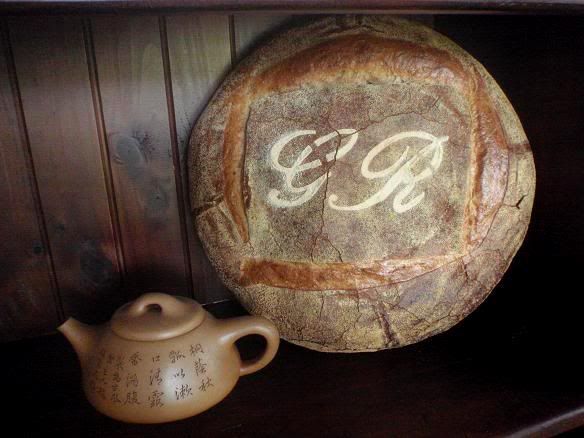
Gérard Rubaud Miche (without pâte fermentée)

Only one of the two miches that I made is shown here, as the stencil of the other one was completely smeared. The proved dough of that one was quite high (its profile was like a tall hill); when I placed the stencil on its surface and dusted flour on it, the flour did not sit well on the surface. I knew there might be problem but went ahead any way. I should have tried to press the stencil closer to the surface of the dough before I dusted flour.
Notwithstanding the above, the aroma was most amazing when the miche was being baked. When the oven door opened, the whole house was filled with the wonderful whole grains roasting fragrance.
The loaves cooled down to have the cracks all over their surface - the top and all around the sides. Part of the reason for that is because these are very high hydration doughs, but more because I tend NOT to leave my dough in the oven with the oven turned off for the last 5 - 10 minutes of baking as many of TFL home bakers do. I tend to give my dough full but shorter bake. The extreme difference in temperatures inside and outside the oven results in the crackling effect on the crusts.
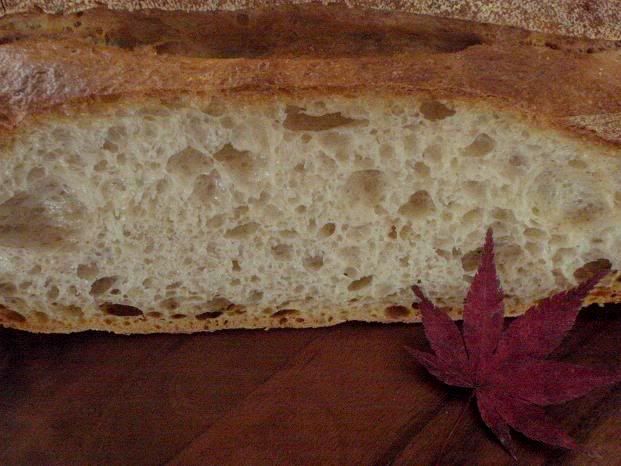

With this Gérard Rubaud formula, I am witnessing the most amazing crumb that I have never seen before. It has a translucent quality about it. It is almost as if each and every particle of the flour had been fermented and each and every cell of the dough has been aerated. I have never seen anything quite like it. It is light and yet a slice of it on you palm feels a weight, a substance. While the crumb looks translucent, it has a sheen as if it is oily (but it is not). You can clearly see the specks of the whole grain flours in the crumb. Had I not made this bread myself, I would not have believed that 30% whole grain flours would give me a crumb like this.
So that is the texture. What about the flavor? I cannot tell you any single flavor. No one taste stands out. I cannot say that it is sour because sourness does not stand out. The taste is very "creamy" if I may use that word. The creaminess and the sourness are beautifully balanced.
MC said of her Rustic Batard that it tastes more whole grains than Gérard's and she wondered if temperature had made a difference as Gérard's bakery is a good 15 degree F warmer than her place. Now, my miche does NOT taste whole grains or wheaty at all. I cannot single out a wheaty taste, but it is there, blended in with all the other flavors. I wonder if my high temperature indeed had made a difference in this. Or, put another way, had MC bulk fermented and proved her Rustic Batard in a proofing box to control temperatures, would she have gotten a closer taste in her Rustic Batard to Gérard's.
Procedure - with pâte fermentée
(Note: the formula is exactly the same as above except with the inclusion of 300 grams of pâte fermentée)
Follow the procedure as for miche without pâte fermentée except for the following:
- One hour after the dough was mixed (ie, at the end of the second set of S&F's, section off a piece of dough weighing 300 g ( reserve it as future pâte fermentée);
- Total fermentation time is shorter by 1/2 hour because fermentation happens faster with this dough. (From the very first set of S&F's, you can already see some strength in the dough because of the acidity from the pâte fermentée. To me, this is quite something, considering the way I mix my dough is that there is no kneading whatsoever, merely stirring to hydrate the flours.)
- As this is a slightly bigger dough (1,920 grams as opposed to 1,770 grams), bake it for one hour.
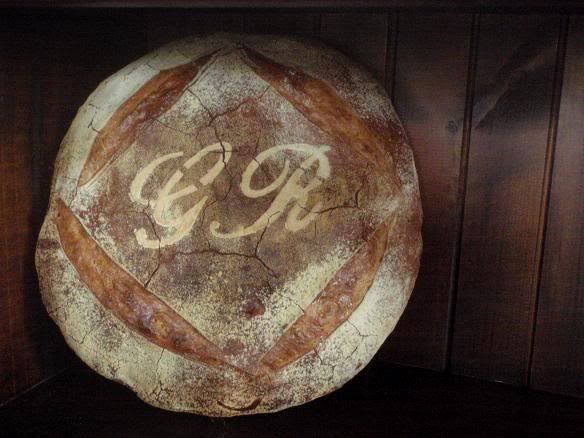
Gérard Rubaud Miche (with pâte fermentée)

I learned something in this bake: that sourdough pâte fermentée will give you extra dough strength because of the acidity in the old dough (provided it is not over-fermented to start with). I am amazed at the volume that I get in this miche. (Let's recap: this dough went through 2 1/2 hours of fermentation at room temperature of 30 degree C, then went into the refrigerator for 9 hour retardation, then baked at 230 C for 1 hour. That's all.)
The taste of this miche is a lot sourer than the previous miche.

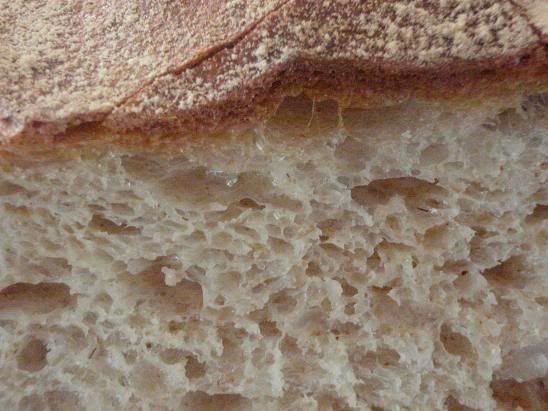
This has been a very fulfilling exercise for me. Thank you, MC, for the wonderful experience.
Shiao-Ping


Comments
Hi Shiao-Ping,
Just getting my oven on for a version of your adaptation of GR MIche, will tell you what happens later, stay tuned.....
Jeremy
I am staying tuned.... is it 8 am where you are?
me too...
Inspired by this recipe from the dough goddess Shiao-Ping and from Capt'Batard's post, I have just baked my 1st 3 build Gérard Rubaud (mini) Miche, but will keep you in suspense with the pics of how it turned out. It's now quite late in the UK so it's one for brekkie (I feel a egg sarnie coming on....). I halved the recipe as a kiloish miche is a bit on the large side for the two us and baked it in my nice big cast iron casserole .......cheers, Steve
Thanks for your comment. You certainly know how to keep us in suspense. I normally wouldn't be able to wait. I notice you have Paul as one of your favourite bakeries in London. There is a very posh looking Paul open in Taipei a couple of years back. (You can see it listed on their website.) Friends advised me not to go there as their breads and pastries are expensive. I finally went there a few months ago when I was back in Taipei and tried half a dozen varieties of their breads and pastries. I love the dining experience there.
Hi Shiao-Ping, Well, not quite as impressive as your professional results, the slightly "ragged" edges are due to my baking in a cast iron pot on baking parchment and as I had a busier day than expected I did not do as many S&F's as required (the dough spent a large part of the day in a cool kitchen) However, i'm looking fwd to frying so eggs to pop between a couple of slices very soon!. As said earlier I roughly halved the recipe and the final product weighed in at 800g exactly. Re the Paul bakeries, i've just checked their website and we have 22 in London!, I like to think they are reassuringly expensive though probably fair for the quality (have'nt been to one for a while) Also, a couple of years ago we had a nice long weekend in Antwerp and the B&B owner used to deliver fresh bread and pastries from Paul every morning to our room, brilliant!. Anyway here are the scruffy bread pics, and thanks for the recipe. Cheers, Steve
... looks very delicious. It has that translucent quality too, a well fermented piece.
Thanks for showing us the photos.
Shiao-Ping
was used, just a token couple of twists of the mill as I stopped adding salt to my food years ago, I get my quota from snacks and fromage. Yep, the bread was very tasty and very similar to my usual everyday sourdough, which (by chance) uses a similar 2-4 type of flour mix depending on what's in the larder, predominately strong white but with added wholemeal, rye and spelt if I have it, starter is always a rye as it's the only one I have (about 15 months old) Regards, Steve
And thanks, too, to MC for bringing Gérard Rubaud and his gorgeous bread to our attention (in my case, through this landmark post of Shiao-Ping's).
I baked this bread for the second time today - on this occasion, two smaller batards as per DMSnyder's version. On removing them from the oven, they crackled at me for 10 minutes! I didn't end up with any notable crazing of the crust, but the flavour was marvellous. No pics, unfortunately, as my old Canon is on the blink.
The first time I baked this bread I did a single batard. You remarked on the great volume you got with your pâte fermentée version, Shiao-Ping, and I have to say I was pretty astounded at the spring I got with this first loaf - and that was using the starter, not a pâte fermentée. Actually, it's the best rise I've ever gotten...the spring literally tore the slash apart! Just wonderful.
I'm thinking of using GB's starter for all my breads from now on. There's something special about that combination and proportion of flours.
I'm also wondering whether that terrific rise is attributable to the lower hydration of this starter - I customarily use either a 100% or 80% hydration starter. Ah, the mysteries, the mysteries...
with liquid starter. (Do yeasts come with a grain of wheat, or with water - you know what I am getting at. In a stiff starter, there is potentially a higher yeast count than in a liquid starter of the same weight.) However, given that this is an overall 80% hydration dough, I would think it's possible that your oven spring was due to a slight under-proof (or at least not over-proof) in your dough, coupled with the fact that you are now more comfortable in handling your dough and reading your dough. Lately I have been researching on the legendary Poilane Miches (Lionel Poilane in particular) and, in general, the real French traditional Pain au Levain. Their doughs are 63 - 65% hydration and their starters are also 63 - 65% hydration because the starters are taken from the last batch of dough (ie. pate fermente). As a relatively junior sourdough baker, I have always believed in higher hydration for more open crumb. But Ross, I believe we can now move on to lower hydration dough and still get a relatively open crumb, but much fuller flavour and more definition in our loaf shape!
Cheers, Shiao-Ping
Very interesting observations, Shiao-Ping. I'd never thought of stiff starters as harbouring more yeast, and therefore having more muscle to lift the dough, but it sure sounds logical to me.
I look very forward to your version of a pain au levain in the authentic lower hydration French style (I have no doubt you'll be featuring that on here very soon!).
I have saved a Polaine recipe courtesy of breadtopia that I've been meaning to try for a while. You've just given me a nudge. Moved to the front of the queue...!
Cheers!
Ross
Thank you for sharing that Poilane inspired recipe. I haven't seen that before. Thanks. These days I don't surf the net as much as I used to, so I often missed a lot of info. That recipe is of course not the Poilane recipe. Lionel Poilane's website is HERE, and Lionel's elder brother, Max Poilane's website is HERE. Lionel Poilane's miche is slashed with a letter P, while Max Poilane's miche has 4 slashes almost like in a square. I maybe wrong but I believe the scoring of Max Poilane miche is closer to how miches were scored during their father, Pierre Poilane's time. Lionel did the big letter P more to distinguish his miches as more people had started to do this style of bread (I maybe wrong again but there was perhaps no such need during Pierre's time as the latter was the pioneer in returning to the somewhat primordial French bread). The Poilane story is interesting to read and on YouTube there are a lot of video about them.
There seems to be an obsession about Poilane miche among artisan bakers and the issue, it seems to me, is about the flavour of bread. It is a well-known fact that Poilane uses the French T80 flour for their miches (and to be honest I do not know if using 80 - 85% bread flour with 15 - 20% wholewheat flour with bran sifted out would be a good match). I am very tempted to order a Poilane miche air-flown into Australia, but I won't. They may decline the order just the same because if they think the delivery takes more than 48 hours they may decline the order. Lionel was known to say that their miche is best for three days, but I really like my bread on the first day. On the issue of the flavor of bread, I am not convinced that bread made with T80 would have the flavour that I want best. Can we take a vote and see if blonde beauty is what people think the absolute beauty? We know the answer. These things are really individual.
On the other hand, having made a Gerard Rubaud style of miche here, I can begin to picture what a T80 miche must be like - the aroma would no doubt be sensational.
Shiao-Ping
Hi Shiao-Ping,
Did you catch this post?
I'm going to have a good read through later; but I thought it may be useful to the discussion you are having here just now.
http://www.thefreshloaf.com/node/16110/baking-la-milanaise-flours
Best wishes
Andy
My French bread books always have recipes that use "unusual" flours to what I am familiar with but I never paid too much attention to them because I have been busy as it is without the different types of flours. But I guess, as with any art form, in the end you come to a place where you crave the simplest because it is in the simplest that your skill is tested. It was in my Gerard Rubaud miche that I first used the 30%/70% mixed whole grains flours and bread flour combination. The result struck a resonance in me. I am now actually looking forward to be working with T80 (or even T110) flours. As with La Meunerie flour, I am going to see if my friend in Montreal can help out.
Thanks and regards,
Shiao-Ping
I agree that there's something magical about the 70:30 bread flour:whole-grain flour ratio! My favourite levain is also a mix of 70% AP flour and 30% whole-grain (25% whole-wheat + 5% whole-rye), and I guess the lightness and openess of the crumb, combined with the full-bodied flavour of wheat and rye, is what strikes a chord in me. Although I haven't tried the Rubaud levain yet, I'm positive it's a formula with the same tasty balance.
I've also wanted to try the real French T55, T65 and T80 flours, if for nothing else than to feel how they are to work with and what flavour they hold. I've never tried them, but used information from this source (click me) to try to "emulate" and combine my own flours to come up with something that's hopefully similar.
If you scroll down to table VIII, you'll see that T80 is labelled as a "light whole-wheat flour". Comparing both extraction rates and ash contents, it seems to me that T80 is closer to the regular whole-wheat flour than it is to AP/bread flour. If I'm not mistaken, Hamelman uses a high-extraction flour with approx. 0.92 ash for his miche, and he suggests substituting something along the lines of 85% whole-wheat flour + 15% bread flour if high-extraction is not available. An 85% WW + 15% bread flour combination appears rather bitter or "earthy" to me... what do you think? Perhaps they key to unlock the Poilane secret is to actually fly a loaf down under... ;-)
As for the 85% WW and 15% bread flour combination, I am very confused myself at this stage. When I did my Miche, Pointe-a-Calliere, as I did not have the high extraction flour, I used 86% WW (Hamelman said between 85% and 90% WW is fine). My miche did not taste "bitter or 'earthy' to me..." but that could be because my Australia WW flour. I think when you "try to 'emulate'" and combine your own flours using the information in the study you provided the link for, you will get something close to the specific French style of flour that you are looking for, but not me. That paper is a study of American flours and European/French flours. I cannot assume that my Australian flours are the same as American flours in general. I am now getting quite weary of all the comparisons and academic stuff. I want a true experience, not a virtual one. If I lay my hands on T80 flour would you like some?
Shiao-Ping, I don't understand why you consider your lovely breads a 'virtual experience', rather than a 'true one.' I guess it's because you are making the basis of your comparisons the original versions of the recipes you're trying and want to get as close as possible to 'the authentic.'
While I fully understand the call of the authentic, and answer it whenever I can (in fact, the notion of authenticity informs my entire food philosophy...but here is not the place to expand on that), I think I have a different perception from you on home baking. I find it fascinating that the home baker can emulate classic breads from all over the world - and people like you, who are always trying new breads based on master bakers' famous loaves, give all of us easier access to a wonderful variety of gorgeous home-baked breads.
That, for me, is truly exhilarating! And when just about every time the results are a wonderful flavoursome bread different from any others one has baked previously, I am not the slightest bit bothered about how my version measures up to the original. We all know that every starter is unique, influenced by locale and the flours it is fed, and lends its own qualities and character to the bread it produces, regardless of the precision with which an original recipe is re-created. So, we're never going to exactly replicate another's bread! And viva le difference, I say!
When I try one of your recipes, I hope to turn out a loaf close to yours in crumb quality and flavour, but I know it will not be exact, and that's not an issue for me in any way, because I'm not trying to replicate your bread. I never try to match your presentation, for example, for two reasons: firstly, I'm not technically capable and don't care to put time into developing stencil skills and the like, and secondly, all my cooking tends to be a bit on the rustic side...it's just not my style to put energy into exquisite presentation. But it is your style! And your style stands out and sets your posts apart - your style, not the styles of the master bakers you're basing your breads on.
I don't even care about flour variations. What we get in Australia is different from elsewhere - fine! It's like wines: different locales produce different qualities in the wine, regardless of the grapes used. Aussies wines are almost always going to be more dominant in fruit tones than their French counterparts, but does that make them inferior? Not necessarily!
I realise that analogy is not exact, since you're concerned with the impact on your bread of flour variations, whereas Chardonnay grapes used in Australia came from France originally, so any difference in the wines produced are a function of growing conditions and technique.
However, what about the notion that local wine producers have evolved a new style of wine out of our different growing conditions? The result: an AUTHENTIC Australian style of wines, which at its best has won accolades globally and largely contributed both to New World wine production and to changing wine-producing techniques in France!
So, in summary, my point is this: why try to do the impossible and replicate a style of bread that has evolved out of a particular region, when you are already creating tremendous bread using local flours? Many years, and sometimes generations of knowledge, have gone into the prototypes on which you're basing breads such as that featured in this thread. It is wondrous that you are turning out loaves that look - and no doubt taste - so brilliant, from your home oven, using local flours...and have been baking bread less than a year, if I recall correctly! What's inauthentic about that?
I respectfully suggest that a new perspective is required here, not expensive imported flour...
Cheers!
Ross
PS: Rather than importing a bread from France that is doubtless going to be in less than prime condition when it reaches you - at huge expense, not only in terms of dollars but also considering the horrendous carbon footprint involved - why not plan a holiday to Europe and sample the real thing in the place of origin? Now that's an authentic bread experience in my book!
There is a famous story in Buddhism: A monk came to a river that separated him from the other shore where he wanted to be. He found himself a "fa," a few planks of wood bound together, that enabled him to get across. Because the "fa" had saved his life, the monk carried it on his shoulder wherever he went and did not want to part with it. The "fa" had become a burden for his life. He no longer needed it, but he was still bound by it.
I really didn't explain myself when I said that "I want a true experience, not a virtual one." That was a hasty remark. Indeed as you indicated, every bread we make is an "authentic" piece of work and true of us and our experience to have made the bread, even when we were just copying some formula. We all know we do not need to use French flours to create good bread. But there is no reason not to use it at least once. The world has so much to offer, we don't need to restrict ourselves. And if we want to try something new, it is not because so we can keep it. We experience something new so we can go beyond it.
In order not to be bound by it, I need first to learn it and experience it - not second hand, or with substitutes. The fact that substitutes may turn out to be the same or better or worse is beside the point.
I do like your perspective (and your holiday suggestion - my daughter and I are planning exactly that). Let me say I respectfully thank you for your comment!
Have a good one!
Shiao-Ping
Can't quite work out the relevance of that Buddhism parable here - too many possible interpretations! - but no matter.
Now that you've clarified, I see that your position is actually less extreme than it appeared to me.
I understand and empathise with your wanting to 'go beyond' the known and try new experiences in a bread baking context, including using French flour. And I would also be curious as to the differences in outcome.
I should add that I moaned and whinged for years about the lack of quality in the commercially available breads here in comparison to Germany, where - as I think I've mentioned before - I spent a year in the mid 80s and discovered great bread for the first time. I ended up concluding that our flour is inferior, which seems weird since we're one of the great wheat exporting countries...but nothing else made sense. Not then. Now I am aware of the vast difference technique can make, and thankfully, sourdough has caught on in a big way here and will surely only grow from here. The bread scene is looking promising indeed.
Your planned trip sounds fabulous - would love to do the same. In the meantime, as you are probably aware, there are some bakers downunder that are attracting global acclaim for their sourdough breads: Baker D Chiroco, in St Kilda, Melbourne, for example. Just a quick flight from where you are...and fares are currently cheap enough to make a weekend bread raid viable - economically, at least! Just a bit too far from Perth, though, unfortunately.
Cheers
Ross
I wanted to dedicate this to the fine people who I worked with in Kent in the South-East of England.
They regularly catch the Chunnel over to France, and are going on "flour runs" to make their lovely breads.
I'm so enjoying your discussion about French flours, ash content, and trying to use regular American [and UK, for that matter] flours to create a similar, and appropriate mix.
I must say, the proportions you come up with, seem very appealing to me.
I have had major problems adding this to my blog; you can find it here for now: http://www.thefreshloaf.com/node/16151/working-french-flour When it's sorted, it should appear on my blog: http://www.thefreshloaf.com/blog/ananda
I think it's there now!!
I have all the photos from my last student practical; we made demi baguettes and brown tinned breads from local flours, and ciabatta and foccaccia with wet doughs from my favourite source. I will post these as soon as possible.
Best wishes
Andy
I have to say that this is the most amazing bread that I have ever baked! Also, I did go through the trouble of grinding my own whole grains to make up the 30%.
Here's my grinder which I got a few days ago. It's the same one that Gerard uses...
The organic grains that I used...
Here's the link to my blog post here on TFL with my method: http://www.thefreshloaf.com/node/16211/city-boy-tries-make-g%C3%A9rard-rubaud-miche
Tim
Thank you for sharing your great results with us here.
Shiao-Ping
well, first off, your loaves are gorgeous, shiao-ping! which is why i am currently attmpting to make this bread myself. i was just wondering about the pate fermentee-how quickly would i need to use it in a bread? i am only planning on making one miche this weekend( we are still chomping on some bread i made the beginning of the week) and i can't see myself getting to another try(provided this one works out well) until the middle or end of next week-will it keep until then?
thanks for sharing your great bread -what beauty!
christina
Thanks for your comment. I don't think you want to wait too long. I would say inside of three days in the fridge, then when you want to use it, bring it back to room temperature before you use it.
In case you are interested- here are the results of my bake
http://www.thefreshloaf.com/node/16663/newbie-question-preshaping-and-shaping#comment-108221
and i totally chickened out on the pate fermentee- by the time my dough was ready to go into the fridge i was so tired that finding a suitable container for the pate fermentee was too much for me and i nixed the idea. next time.........
christina
Hello Shiao-Ping
I may be entirely too late for a response to your wonderful post making Gerard Rubauds miche, however I am willing to ask hoping someone can answer.
Better late than never I say (even if it has been 12.5 years since your first posted, lol).
What I am wondering is, is building your GR starter in 3 steps needed each and every time you make one of his Miche or is that simply for the first build where a little is taken off the last dough for the next one?
Next is how did you arrive at the portions for each step of the 3 part build? It seemed a little random to me or am I missing the science behind the technique?
Thanks again for posting, I am looking forward to trying your experiment.
Hopefully you can hear me from the ether.
All the best
Peter 🤞😉
Hi Peter, thank you for your comment and questions, and No, you are not late, I am still here.
On the top of my head, I would say the 3 steps are required for each and every time you make this GR bread just because this is Gérard's way of making his own breads. He died some years after my visit.
Next, how did I arrive at the portions for each step of the build? I would say it was just simple math - I knew how big I wanted my final bread for the size of my oven and my family; I took the formula in MC's post (she is the expert on GR breads) and did a mathematic calculation to arrive at the portions for each step. If you are interested in Gérard Rubaud breads, I would suggest you check out MC's blog.
Finally, I would say at the home level, any freshly baked sourdough is exceptional - the aroma coming out of the oven is just heaven, if nothing else - I would not get too hung up on the build process. What I am saying is you could simply follow your usual sourdough process of re-freshing your starter (which I think is ver key), proper bulk fermentation (another key, hahah), and proofing and baking. You'll get great breads anyway. Just make sure you incorporate the type of ingredients that Gérard used.
All the best, Shiao-Ping
P.S. I stopped posting for a long while, one reason for which was writing English was, and still is, not easy for me; it just seemed to take so much time.
Thank you so much for your response.
I fully was not expecting to receive one.😅So this is wonderful.
I was sorry to hear of Gerard's passing. After reading MC's post I was ready to reach out to him and ask if I could take one of his weekend seminars.
In one of MC's blogs, she mentions the "the taste of bread" book which I paid for (even though it was totally over priced because its out of print😥). I still felt it was a good book to have.
Now that I have it I am happy I purchased it. Its a wealth of information and shows the 3 step way of doing it that is a little different from GR but also very similar.
The way MC talked about GR I felt I would have liked him as a person and still would have liked to have got to meet him.
In a way I have thanks to MC and all I have read about him online.
I wish him well in his journey.
Thanks again so much for taking the time to respond and for your explanation.
It is helpful. I'm still working on finding my own expression of my bread.
I am currently building my starter and close to baking.
I'll share some photos of my loaves once done.
Warm regards from the other side of the ether
Peter
Well, it didnt quite work out.
It wasn't terrible but wasn't great either.
My build was about 6 hours apart each and then 4 hours of bulk fermentation at 27'C
However, I adjusted the water to account for the low hydration in the stiff starter to give the whole thing 70% (which usually isnt a problem)
Its the first time I'm using all purpose flour instead of high protein bread flour.
My guess is too long a fermentation for the strength of the gluten present in my APF and possibly my hydration was too high for the gluten strength in my APF.
Very sad 😥 😅
It was late at night when I put the final loaves in my oven (I got 3 at around 1.8 k) and I didnt score them.
I was worried if I did they would spread a lot more than they were already and spread off my deck. Oh, they were definitely over proofed too 😅
So I made a lot of mistakes.
Next round I'll try and make the same flour combination work (the taste is nice) , I'll lower the hydration, shorten the build times to maybe three hours each and shorten the final bulk to 3 hours as well.
This time around I'll be much more careful not to over extend anything.
Deep breath and ready to dive in again...
I've taken pics of my little horrors (not that bad lol) and will show them once ive achieved better results.
All the best
Peter
... sounds like a good plan. I often find it frustrating, in fact, very frustrating, that bread maker did not specify the temperature at which their dough was fermented. Then when your dough did not spring in the oven, you're left, wondering why. The dough gets over fermented so easily especially when there's whole grains flour in the build (given that it's summer where you are, right?). One last point: it's very easy to over-correct. At each successive built as well as bulk fermentation, I would at least use eye-test or finger poking, to make sure that the dough is somewhat "elevated," like there is air inside it and somewhat soft to the touch. If the dough is NOT fermented sufficiently, then the result is worse than when it is over-fermented I feel. Anyway, good luck!
I'm more experienced with Tartine style high hydration doughs and using a really strong flour (like 14-15% protein) but I never thought of using the finger tests for a bulk fermentation so that is really good advice.
I'd say its the third time now working with whole grains and every time I've over-fermented. Except for Poilanes method. I followed their recipe to the letter and it turned out pretty good but the fermentation times were much shorter and partially in the fridge. Actually, I just remembered I shortened the bulk fermentation time because I was retarding over-night.
Actually Poilanes book led me to MC's blog about Gerard Rubaud (RIP) who led me to the taste of bread and now here for some advice.
I can tell you though for me personally the stiff starter is the way to go. its lactic acid qualities are really mild and milky.
Come to think of it, I may be over-fermenting my stiff starter as I have heard the yeast activity is much stronger in the stiff rather than the 100%
Hmmm, food for thought. In fact, I think that may be one of the culprits.
And oh yes, its summer here. I live in beautiful Victoria BC.
Though it is usually around 20'C so not that hot.
I have a small proofing box to maintain 27'C
So next step is lots of poking and writing down the temps and times.
Thanks again for the advice
and I'll share how its going.
I'm about to make baguettes using Tartines recipe from book three and will try again tomorrow with the stiff starter for a GR Miche.
All the best and enjoy your summer.
Pages